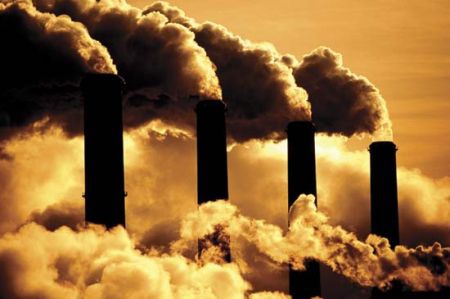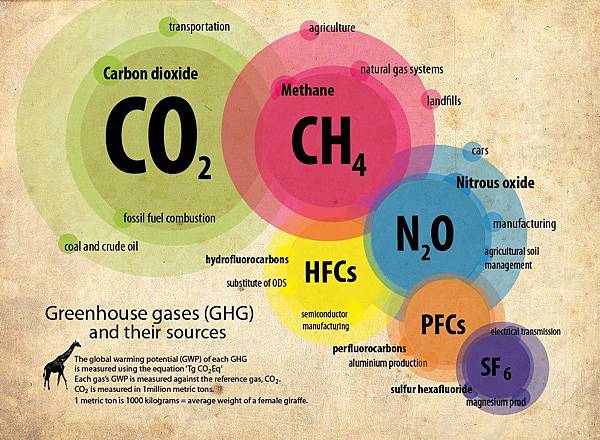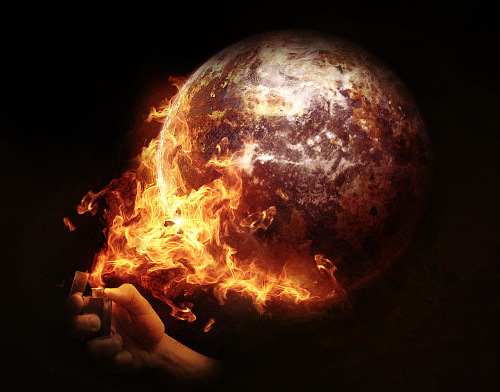![]() 托福閱讀 練習小短文 - 空汙與全球暖化的影響 (環保與化學學科)
托福閱讀 練習小短文 - 空汙與全球暖化的影響 (環保與化學學科) ![]()
這篇文章專有名詞雖多,但是內容是非常容易理解的,是有關 air pollution 空汙的議題,談論的內容就是造成全球暖化影響的greenhouse gas 溫室氣體的相關內容講解。或許有不少化學相關專有名詞,但是整理而言這個議題並是新聞專題常見的談論主題,所以不論出在聽力或閱讀都是極有可能,在本身已理解的前題狀況下,關鍵就是對單字的掌握了。

air pollution
Here's what you need to know about the warming planet, how it's affecting us, and what's at stake.
Smog hanging over cities is the most familiar and obvious form of air pollution. But there are different kinds of pollution—some visible, some invisible—that contribute to global warming. Generally any substance that people introduce into the atmosphere that has damaging effects on living things and the environment is considered air pollution.
Carbon dioxide, a greenhouse gas, is the main pollutant that is warming Earth. Though living things emit carbon dioxide when they breathe, carbon dioxide is widely considered to be a pollutant when associated with cars, planes, power plants, and other human activities that involve the burning of fossil fuels such as gasoline and natural gas. In the past 150 years, such activities have pumped enough carbon dioxide into the atmosphere to raise its levels higher than they have been for hundreds of thousands of years.
Other greenhouse gases include methane—which comes from such sources as swamps and gas emitted by livestock—and chlorofluorocarbons (CFCs), which were used in refrigerants and aerosol propellants until they were banned because of their deteriorating effect on Earth's ozone layer.

Another pollutant associated with climate change is sulfur dioxide, a component of smog. Sulfur dioxide and closely related chemicals are known primarily as a cause of acid rain. But they also reflect light when released in the atmosphere, which keeps sunlight out and causes Earth to cool. Volcanic eruptions can spew massive amounts of sulfur dioxide into the atmosphere, sometimes causing cooling that lasts for years. In fact, volcanoes used to be the main source of atmospheric sulfur dioxide; today people are.
Industrialized countries have worked to reduce levels of sulfur dioxide, smog, and smoke in order to improve people's health. But a result, not predicted until recently, is that the lower sulfur dioxide levels may actually make global warming worse. Just as sulfur dioxide from volcanoes can cool the planet by blocking sunlight, cutting the amount of the compound in the atmosphere lets more sunlight through, warming the Earth. This effect is exaggerated when elevated levels of other greenhouse gases in the atmosphere trap the additional heat.

Most people agree that to curb global warming, a variety of measures need to be taken. On a personal level, driving and flying less, recycling, and conservation reduces a person’s "carbon footprint"—the amount of carbon dioxide a person is responsible for putting into the atmosphere.
On a larger scale, governments are taking measures to limit emissions of carbon dioxide and other greenhouse gases. One way is through the Kyoto Protocol, an agreement between countries that they will cut back on carbon dioxide emissions. Another method is to put taxes on carbon emissions or higher taxes on gasoline, so that people and companies will have greater incentives to conserve energy and pollute less.



 留言列表
留言列表